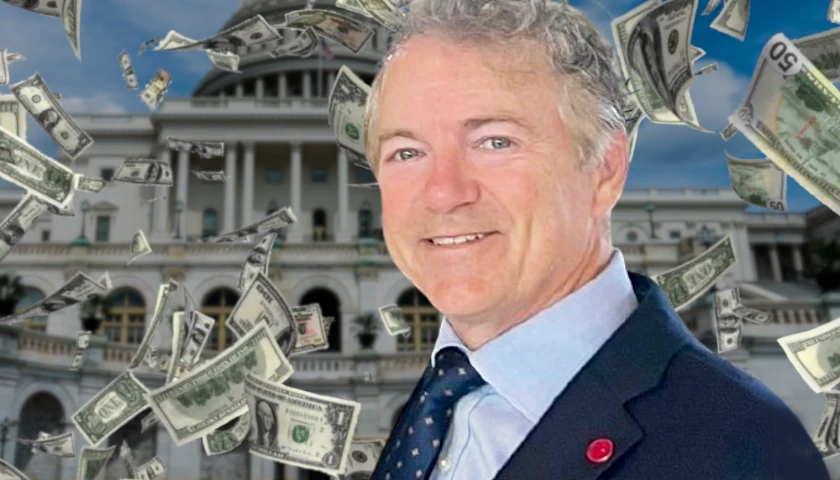by Edward Ring
If you’ve navigated the thicket of microinstructions, hectoring, guilt-tripping, institutionalized resentment, establishment-generated misinformation, double standards, and bizarre new terminology, then welcome to the world of woke antiracism in America today.
One of the biggest absurdities spread by the woke antiracists is that white people must practice “allyship” and refrain from sharing their opinions on race relations with “people of color.” There is nothing wrong with listening as well as talking, but for white people to remain silent in the face of one of the most destructive movements in American history is negligent and cowardly.
As it is, progressive elites in America, almost all of them white, are indoctrinating nonwhites in America to believe that they live in an oppressive, racist nation. They are falsely told that unjustified police violence disproportionately targets blacks. They are falsely told the biggest threat to the nation is white supremacists. Worse still, they are told that every disparity in achievement between races is a product of white racism, and that white racists are to blame for any failures in their individual lives or within their communities.
The motivation for this indoctrination is political and economic. America’s corporate socialist uniparty—all of the Democrats and a sizable percentage of Republicans—finds power and profit in selling this narrative. It justifies expanding government, nurturing dependency, unchecked immigration, and building the welfare and diversity bureaucracies. It creates a divided and fractious electorate that is incapable of recognizing this political betrayal and unifying to stop it.
The fruits of woke indoctrination are that an overwhelming majority of blacks, Latinos, and Asians vote for “progressive” politicians. In the 2020 election, Biden was supported by 87 percent of black voters, by 61 percent of Latinos, and by 63 percent of Asians. These partisan margins have become the decisive swing vote that is changing the destiny of America. Which is to say, America used to be a country where property rights and free speech were paramount values, but today it is being converted into a corporate socialist dystopia where there are only oligarchs and serfs dependent on government handouts. And as this epic, life-changing transformation occurs, white people are told to just shut up and be “allies.”
There are plenty of brilliant conservative black intellectuals who are doing a good job of exposing how the fraudulent, destructive essence of woke ideology harms everyone regardless of their ethnicity: Thomas Sowell, Larry Elder, Carol Swain, and other well-established luminaries, along with thousands of younger entrants such as Candace Owens and Brandon Tatum. The emergence of black conservatives, too numerous to mention, is an encouraging pushback against the woke minions and their corporate backers. Others, such as Indian-Americans Vivek Ramaswamy and Dinesh D’Souza, have also become important conservative thinkers.
So with their help, it’s time to mainstream a position that is unfairly depicted by the “woke” as something only a “far-right extremist can think”—namely, that for several decades America has been a systemically racist nation against white people, and has more recently begun to also discriminate against Asians, especially in college and university admissions. This is harming everyone, including the nonwhites it is alleged to help.
The Origins of Racism to Achieve Diversity
Anti-white discrimination is nothing new. Anti-white racism began in the 1970s when the principles of affirmative action, originally designed to outlaw discrimination of any kind, were expanded to mandate what critics called “reverse discrimination” in order to fulfill “diversity benchmarks.” In practice, this led to colleges and universities admitting new students not based on their grades and scores on standardized tests but based instead on achieving proportional representation by race.
These racist practices soon spread to the corporate world. They took the form of tax creditsfor companies to hire women and minorities, tax incentives offered to “women and minority owned businesses,” and mandates for government agencies to give preference to those businesses when evaluating bids for government contracts.
It was already common in the 1990s for job recruiters to disregard white applicants. They wouldn’t even be evasive about it. “We can’t hire another white man,” they’d say, knowing their exposure to a lawsuit was minimal, despite the fact that if they said the opposite, “we are only going to hire white men,” they’d soon be in a civil court fighting for their financial and professional survival.
Where successful lawsuits and ballot initiatives have challenged affirmative action, it has morphed into less explicit but equally racist antiwhite practices. For example, once voters rejected affirmative action in California in 1996, the state’s colleges and universities began to warp the criteria away from grades and test scores in favor of subjective “personal scores” and a “holistic” approach that enabled their admissions offices to continue to achieve proportional representation by race.
Let’s suppose the idea that we must discriminate in favor of nonwhites wasn’t completely unfounded when it originated. Back in the early days of affirmative action, when the nonwhite population of America was only around 15 percent, it was an experiment that seemed worth trying. But now that college-age, non-Hispanic whites are only 50 percent of the population, proportional representation by race, irrespective of aptitude, carries serious consequences for America’s future.
In higher education today, from the most elite universities in America all the way to relatively unremarkable state colleges, and from postdoctoral all the way to undergraduate freshmen, there are millions of students who were admitted not based on their scholastic aptitude but, again, in order to achieve proportional representation by race. And for each one of these millions, there is a white or an Asian student who was denied a spot despite earning higher grades and scoring higher on aptitude tests.
Asian Communities Challenge Discrimination
A lawsuit brought by Asian students against Harvard University, now before the U.S. Supreme Court, exemplifies just how racist America’s universities have become. As reported earlier this month in the New York Post, in reference to an ongoing anti-discrimination lawsuit, “As SFFA [Students for Fair Admissions] noted in its Harvard petition, ‘an Asian American in the fourth-lowest decile has virtually no chance of being admitted to Harvard (0.9%); but an African American in that decile has a higher chance of admission (12.8%) than an Asian American in the top decile (12.7%).’”
This is an incredible fact. A black applicant to Harvard with test scores in the bottom 40 percent is more likely to get admitted to Harvard than an Asian applicant with test scores in the top 10 percent. This sort of discrimination has been institutionalized across America. The University of California, still one of the top institutions of higher learning in the world, has now scrapped the SAT test altogether, despite its value in predicting an applicant’s future academic success.
What was a well-intentioned scheme back in the 1970s to give opportunities to minorities who, at the time, still represented a small minority of the U.S. population, has morphed into a monstrous charade that favors what is imminently a majority of the U.S. population. In nearly every American institution of higher learning, nonwhite, non-Asian students are attending classes in which, on average, they lack the scholastic aptitude to excel. To adapt, colleges have watered down coursework, conceived new majors that lack academic rigor, and built an expensive diversity bureaucracy to coddle students who shouldn’t be attending these schools in the first place.
Undermining the Medical Profession
In a recent essay for City Journal by the incomparable Heather Mac Donald, the inevitable consequences of anti-white, anti-Asian racism are laid out in searing detail. Although “The Corruption of Medicine” shows how institutional racism has undermined the quality of America’s medical schools and is now infiltrating the broader medical community, what Mac Donald describes is happening everywhere, in every sector of the U.S. economy.
Skeptics who still think “white privilege” is one of the greatest challenges to America today need to read Mac Donald’s nearly 6,000-word report. Highly compensated diversity brigades, comprised of opportunists, mediocrities, and lunatics, have taken over the medical profession just as thoroughly as they have taken over academia. They’ve forced medical schools to disregard Medical College Admission Test scores to favor nonwhite, non-Asian students; they’ve even forced residency programs to disregard student scores on the U.S. Medical Licensing Exam taken after their second year of medical school. Once considered crucial to earning admission to a residency, this test measures “knowledge of the body’s anatomical parts, their functioning, and their malfunctioning; topics include biochemistry, physiology, cell biology, pharmacology, and the cardiovascular system.” You know, material it might be nice for your doctor to have mastered. But the skills gap among races meant the MCAT and the USMLE had to go.
It gets worse. Mac Donald writes:
Mandatory [medical school] instruction in politicized concepts helps diversify the faculty and administration—for who better to teach about oppression than a person of color? (Part of the appeal of diversity trainings and bureaucracy, whether in academia or the corporate world, lies in the creation of new employment slots dedicated to diversity activities, which can be filled without as great a sacrifice of meritocratic standards.) But being indoctrinated in ‘intersectionality’ does nothing to improve a student’s clinical knowledge. Every moment spent regurgitating social-justice jargon is time not spent learning how to keep someone alive whose body has just been shattered in a car crash.
And it almost goes without saying, anyone in the medical profession who dares to say something like “we should not lower our standards,” or “we should focus on teaching medicine instead of intersectionality,” or “we need to fund bioinformatics to cure cancer, not ‘equity’ research,” becomes a pariah.
As for talented students who are white or Asian, Mac Donald reports they are not optimistic:
College seniors, deciding whether to apply to medical school, can read the writing on the wall. A physician-scientist reports that his best lab technician in 30 years was a recent Yale graduate with a B.S. in molecular biology and biochemistry. The former student was intellectually involved and an expert in cloning. His college GPA and MCAT scores were high. The physician-scientist recommended the student to the dean of Northwestern’s medical school (where the scientist then worked), but the student did not get so much as an interview . In fact, this ‘white, clean-cut Catholic,’ in the words of his former employer, was admitted to only one medical school. Such stories are rife. A UCLA doctor says that the smartest undergraduates in the school’s science labs are saying: ‘Now that I see what is happening in medicine, I will do something else.’ [emphasis added]
Diversity Mandates Are Destroying American Institutions
And as one institution after another devotes more of its human resources to “research” devoted to uncovering examples of disproportionate representation in something, anything, as a way to keep its less qualified hires busy, brilliant medical and scientific researchers are sidelined, unable to find a job because of their color. Researchers are deferring work that is vital to the advancement of science and technology, to the detriment of America’s competitiveness and at the cost of desperately anticipated breakthroughs in medicine, energy, and every other vital cutting-edge endeavor.
This must end. How must nonwhite, non-Asian students and professionals feel, when they are highly qualified, but know their colleagues cannot help but wonder if they only got their spot because of their color? How can patients, or clients, feel about relying on a nonwhite, non-Asian doctor or other professional, if they have to wonder if the person they’re depending on only has that position because of their color? How can people with character work in an environment where they are constantly called upon to endorse the dogma of diversity, equity, and inclusion, all while knowing it has devolved into an authoritarian and racist fraud?
The history of the United States includes examples of systemic racism that harmed nonwhites. That is tragic and regrettable, but it is consistent with the story of every culture or tribe in the history of the world. This tragedy can be acknowledged without it having to overshadow the great opportunities that are available to anyone living in America today, regardless of their ethnicity.
What is unique in America is not its legacy of oppression, which is universal throughout history, but rather how American culture has defied the momentum of history, by systematically rejecting racist, tribal behavior, and built the most inclusive civilization the world has ever seen. But inclusion, at every level of society, must be based on merit. Without merit and competence as the sole basis for success, there is no incentive for individuals to work hard, and there is no sense of shared accomplishment.
Without merit and competence as an immutable requirement to ascend academically and professionally, America’s institutions cannot hope to operate at their full potential, and there is no chance for Americans, regardless of their color, to truly believe they live in a fair society.
Racism is racism. For everyone’s sake, Americans of all ethnicities must unite to reject racism of all kinds and embrace becoming a colorblind meritocracy. It is the only way to preserve the character and vitality of America and its people.
– – –
Edward Ring is a senior fellow of the Center for American Greatness. He is also is a contributing editor and senior fellow with the California Policy Center, which he co-founded in 2013 and served as its first president. Ring is the author of Fixing California: Abundance, Pragmatism, Optimism (2021) and The Abundance Choice: Our Fight for More Water in California (2022).





